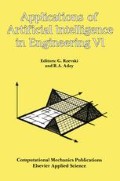Abstract
An intelligent tool for the modelling and analysis of electromagnetic interactions in a complex electrical system is described. The purpose is to determine any unwanted electromagnetic effects which could jeopardize the safety and operation of the system. Modelling the interactions in a system requires the examination of the compounded and propagated effects of the electromagnetic fields. The approach taken here subdivides the modelling task into two parts: a) the definition of the related electromagnetic topology, and b) the propagation of the electromagnetic constraints. HardSys, a prototype object-based system implemented in Prolog, is used to propagate the electromagnetic constraints. User interaction is through HardDraw, a topology-drawing tool and an attribute interface.
Access this chapter
Tax calculation will be finalised at checkout
Purchases are for personal use only
Preview
Unable to display preview. Download preview PDF.
References
LoVetri, J., Abu-Hakima, S., Podgorski, A. S., Costache, G. I., “HardSys: Applying Expert System Techniques to Electromagnetic Hardening”, IEEE 1989 National Symposium on Electromagnetic Compatibility, pp. 383 – 385, Denver, Co., May 23–25, 1989.
LoVetri, J., and Graham, D. P. W., “Constraint Propagation Through Electromagnetic Interaction Topologies”, ANTEM’ 90, Symp. on Antenna Tech. and Appl. Electromagnetics, Winnipeg, Manitoba, August 15–17, 1990.
LoVetri, J., and Podgorski, A. S., “Evaluation of HardSys: A Simple EMI Expert System”, 1990 IEEE Int. Symp. on EMC, Washington, D.C., August 21–23, 1990.
Baum, C. E., “Electromagnetic Topology, A Formal Approach to the Analysis and Design of Systems”, Interaction Notes, Note 400, Air Force Weapons Lab, September, 1980.
Baum, C. E., “On the Use of Electromagnetic Topology for the Decomposition of Scattering Matrices for Complex Physical Structures”, Interaction Notes, Note 454, Air Force Weapons Lab, July, 1985.
Messier, M. A., “EMP Hardening Topology Expert System (Hard Top)”, Electromagnetics, vol. 6, no. 1, pp. 79 – 97, 1986.
Tesche, F. M., “Topological Concepts for Internal EMP Interaction”, IEEE Trans, on Ant. and Prop., vol. AP-26, no. 1, pp. 60 – 64, Jan., 1978.
Schulz, R. B., Plantz, V. C. and Brush, D. R., “Shielding Theory and Practice”, IEEE Trans. Electromagn. Compat., vol. 30, no. 3, pp. 187 – 201, August, 1988.
U.S. Department of Defense, “Measurement of Electromagnetic Interference Characteristics”, Mil-Std-462, July 31, 1967.
McDonnel Douglas Astronautics Co. Integrated Circuit Electromagnetic Susceptibility Handbook, Report MDG-E1929, Box 516, St. Louis, Missouri, (314) 232–0232, August 1978.
Duff, W. G., Fundamentals of Electromagnetic Compatibility, A Handbook Series on Electromagnetic Interference and Compatibility, vol. 1, Interference Control Technologies, Inc, Gainesville, Virginia, 1988.
Ott, H. W., Noise Reduction Techniques in Electronic Systems, John Wiley & Sons, New York, 1988.
Vitek, G, “Predicting the Shielding Effectiveness of Rectangular Apertures”, IEEE 1989 National Symposium on EMC, Denver, Colorado, pp. 27 – 32, May 23 – 25, 1989.
Raut, R., “On the Computation of Electromagnetic Field Components from a Practical Printed Circuit Board”, 1986 IEEE Int. Symp. on EMC, pp. 161 – 166, San Diego, CA, Sept. 16 – 18, 1986.
Sussman, G. J. and Steele, G. L., “Constraints — A Language for Expressing Almost-Hierarchical Descriptions”, Artificial Intelligence, vol. 14, pp. 1 – 39, 1980.
Montanari, U., “Networks of Constraints: Fundamental Properties and Application to Picture Processing”, Information Science, vol. 7, pp. 95 – 132, 1974.
Clocksin, W. F. and Mellish, C. S., Programming in Prolog, Springer-Verlag, New York, 1984.
Dijkstra, E. W., “A Note on Two Problems in Connexion with Graphs”, Numerische Mathematik, vol. 1, pp. 269 – 271, 1959.
Ahuja, R. K., Mehlhorn, K., Orlin, J. B., and Tarjan, R. E., “Faster Algorithms for the Shortest Path Problem”, J. of the Ass. for Comp. Mach., vol. 37, no. 2, pp. 213–223, April 1990.
Bondy, J. A., and Murty, U. S. R., Graph Theory with Applications, American Elsevier Pub. Co., Inc., 1976.
Arden, M.J., Gosling J. and Rosenthal, D. S. H., The NeWS Book, Springer-Verlag, 1989.
The Turing Institute, Good NeWS1.3 User Guide, The Turing Institute, Glasgow, Scotland, September, 1989.
The Turing Institute, Hyper NeWS1.3 User Manual, The Turing Institute, Glasgow, Scotland, September, 1989.
Quintus Computer Systems Inc., Quintus Prolog Development System Manual (Release 2.4), Quintus Computer Systems Inc., Mountain View, California.
Stabler Jr., E. P., “Object-Oriented Programming in Prolog”, AI Expert, pp. 46–57, October 1986.
Author information
Authors and Affiliations
Editor information
Editors and Affiliations
Rights and permissions
Copyright information
© 1991 Computational Mechanics Publications
About this chapter
Cite this chapter
LoVetri, J., Henneker, W. (1991). HardSys/HardDraw: A Smart Topology Based Electromagnetic Interaction Modelling Tool (NRC number 31804). In: Rzevski, G., Adey, R.A. (eds) Applications of Artificial Intelligence in Engineering VI. Springer, Dordrecht. https://doi.org/10.1007/978-94-011-3648-8_23
Download citation
DOI: https://doi.org/10.1007/978-94-011-3648-8_23
Publisher Name: Springer, Dordrecht
Print ISBN: 978-1-85166-678-2
Online ISBN: 978-94-011-3648-8
eBook Packages: Springer Book Archive

